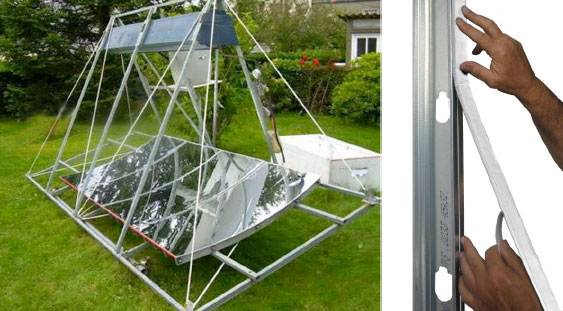Thermablok® News Stories
Thermablok® Aerogel News Stories
Acoustiblok, Inc. Donates Thermablok® Aerogel Us3ed to Insulate Solar Autoclave, Addresses Long-Standing Health Issue for Developing Countries
 Incorporating Thermablok’s aerogel insulating technology, Capteur Soleil may now be used to sterilize medical instruments in developing countries, where sterilizing medical equipment is impossible in regions with no electricity.
Incorporating Thermablok’s aerogel insulating technology, Capteur Soleil may now be used to sterilize medical instruments in developing countries, where sterilizing medical equipment is impossible in regions with no electricity.Combining the unrivaled insulating properties of aerogel technology and a decades-old device created by French inventor Jean Boubour, Rice University engineering students are harnessing the sun’s energy to power an autoclave that can be used in developing countries, where electricity is rare or non-existent, to sterilize medical instruments and help solve a long-standing health problem.
Engineering students incorporated a thin layer of Thermablok aerogel insulation in the autoclave’s plywood frame to provide the thermal protection necessary in any climate and terrain. Thermablok’s aerogel has the highest insulating properties of any material known to man. This technology was developed in conjunction with NASA’s application of aerogel use in shuttle and mars missions. For this reason, Thermablok was the perfect insulator for the project, according to Sam Major, Rice University senior engineering student.
“The thin layer of Thermablok does the work,” Major said. “We used standard pink insulation to make the box stronger, but the Thermablok handles the insulation on its own.” The students used Capteur Soleil, a device created decades ago by French inventor Jean Boubour to capture the energy of the sun in places where electricity, or fuel of any kind, is hard to get or nonexistent. By attaching the Thermablok-insulated box containing the autoclave, the students transform the device into a potential lifesaver.
The Capteur Soleil, which sits outside Rice’s Oshman Engineering Design Kitchen, looks something like an ultramodern lawn swing. Its spine is a steel A-frame, and a bed of curved mirrors beneath the frame produces steam by focusing sunlight along a steel tube at the frame’s apex. Rather than pump steam directly into the autoclave, the Rice team chose to use the steam to heat a custom-designed conductive hotplate.
“It basically becomes a stovetop, and you can heat anything you need to,” said Major. “As long as the autoclave reaches 121 Celsius for 30 minutes (the standard set by the Centers for Disease Control and Prevention), everything should be sterile, and we’ve found we’re able to do that pretty easily.”
He said one person could easily adjust the Capteur Soleil by ratcheting up the back leg to align the mirrors with the sun. Within half an hour of receiving strong sunlight, the Capteur Soleil will begin to produce steam, which will in turn heat the patterned hotplate and then the standard-issue, FDA-approved autoclave. With good midday sun, Major said, it takes 40 minutes to an hour to begin significant heating of the autoclave.
The autoclave, which has a steamer basket inside, holds about an inch of water inside, followed by the basket with the tools and syringes to be sterilized.
“We’ve used some biological spores from a test kit, steamed them, and then incubated them for 24 hours and they came back negative for biological growth,” Major said.
“This is really the latest iteration of a much larger project,” said Doug Schuler, the team’s faculty adviser and an associate professor of business and public policy at Rice’s Jones Graduate School of Business.
“We already have a version of the Capteur Soleil being used in Haiti for cooking, but we felt it could do more.”

